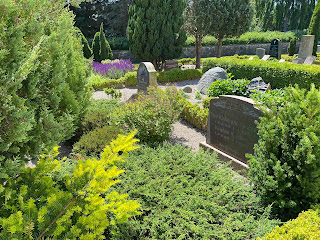The sky at 1am in Bodo, Norway.
On this trip I traveled to or through eight countries. Three are my favorite destinations in the world: France, Germany and Italy. Two I just passed through: Turkey and Sweden. Three I visited for the first time: Denmark, Norway and the Vatican. In each of the countries I was in for the first time, I had an experience that only being in that place could give me.
In Bodo, Norway, I was above the Arctic Circle. At 1am, when the sun is due north in the northern hemisphere during Daylight Savings Time, I was walking around Bodo. I took the picture above of the cloudy sky with the sun shining in from due north. I have known this to be true since I first understood Earth's orbit, but seeing it made me irrationally happy. The sun really was visible due north!
In Denmark my friend Cliff and I visited Panzer Museum East southwest of Copenhagen. On the way to Denmark a few days before, we visited Deutsches PanzerMuseum north of Hannover. That museum, like most military museum, celebrates the weapons of that country. The museum in Denmark does not. The collection of hundreds of tanks, trucks, armored vehicles, missiles, aircraft, cannon, medical equipment, engines, radar systems and other equipment is Soviet-made.
The museum is designed to be a warning: If the Soviets had invaded Western Europe, these vehicles would have been attacking our country. In a chilling update of the collection, the vehicles that Putin's Russia is using to invade Ukraine are tagged in the display. Nowhere in the museum is any vehicle or equipment ever used by the Army of Denmark.
Also in Denmark, I learned about very different burial practices common in both Denmark and Germany. Headstones and burial plots are rented for 25 or 50 years. Then someone gets the space. I wrote about that here.
The third country I visited was the Vatican. Like Monaco, San Marino, Andorra, Luxembourg and Liechtenstein, it is a city state, a member of the United Nations with its own government, but the size of a city. Over the past fifteen hundred years the Vatican has had vastly different levels of power. Its current status as an independent state was granted by the fascist dictator Benito Mussolini in 1931.
Before visiting the Vatican, I read a lot about the Catholic Church in Germany. Before and during the trip I was The Pope at War: The Secret History of Pius XII, Mussolini, and Hitler by David I. Kertzer. The book is based on Vatican archives opened in 2020 that detail long-hidden history of Pope XII with Hitler and Mussolini.
I took a train to the Vatican and rode a bike to St. Peters Square. I walked into the vast plaza and was overwhelmed with sadness. 'To keep this you let all the Jews die,' was what I thought as I walked looking up at the statues and the fountain. Everything about the place screamed temporal power. This was a place of riches and political influence.
I left and went back to Rome, which was another revelation for me. No amount of reading or maps prepared me for how small the area was that encompassed the Palatine Hill, the Colosseum, the Capital, markets, baths, temples, circuses, all in a relatively small space.
Travel to a new place is its own reward.















































